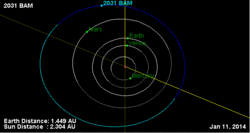Astronomy:2031 BAM
 Orbital diagram of BAM | |
| Discovery [1] | |
|---|---|
| Discovered by | L. Chernykh |
| Discovery site | Crimean Astrophysical Obs. |
| Discovery date | 8 October 1969 |
| Designations | |
| (2031) BAM | |
| Named after | Baikal–Amur Mainline [2] (Siberian railway line) |
| 1969 TG2 · 1939 VB 1959 TW · 1972 NQ | |
| Minor planet category | main-belt · (inner) Flora [3][4] |
| Orbital characteristics [1] | |
| Epoch 4 September 2017 (JD 2458000.5) | |
| Uncertainty parameter 0 | |
| Observation arc | 77.39 yr (28,268 days) |
| |{{{apsis}}}|helion}} | 2.6203 AU |
| |{{{apsis}}}|helion}} | 1.8477 AU |
| 2.2340 AU | |
| Eccentricity | 0.1729 |
| Orbital period | 3.34 yr (1,220 days) |
| Mean anomaly | 124.02° |
| Mean motion | 0° 17m 42.72s / day |
| Inclination | 4.7524° |
| Longitude of ascending node | 169.28° |
| 213.58° | |
| Physical characteristics | |
| Dimensions | 7.14 km (calculated)[3] 8.14±0.36 km[5] |
| Rotation period | 10.774±0.004 h[6] |
| Geometric albedo | 0.170±0.017[5] 0.24 (assumed)[3] |
| S [3][7] | |
| Absolute magnitude (H) | 12.9[1][3] · 13.00[5] · 13.05±0.81[7] |
2031 BAM, provisional designation 1969 TG2, is a stony Florian asteroid from the inner regions of the asteroid belt, approximately 8 kilometers in diameter. It was discovered on 8 October 1969, by Soviet astronomer Lyudmila Chernykh at the Crimean Astrophysical Observatory in Nauchnyj, on the Crimean peninsula.[8] The asteroid was named for those who built the Baikal–Amur Mainline (BAM; БАМ), a Siberian railway line.[2]
Orbit and classification
BAM is a member of the Flora family (402),[3][4] a giant asteroid family and the largest family of stony asteroids in the main belt.[9]:23 It orbits the Sun in the inner asteroid belt at a distance of 1.8–2.6 AU once every 3 years and 4 months (1,220 days; semi-major axis of 2.23 AU). Its orbit has an eccentricity of 0.17 and an inclination of 5° with respect to the ecliptic.[1]
The body's observation arc begins with its identification as 1939 VB at Uccle Observatory in November 1939, almost 30 years prior to its official discovery observation at Nauchnyj.[8]
Physical characteristics
BAM has been characterized as a stony S-type asteroid by Pan-STARRS photometric survey.[7]
Rotation period
In October 2016, a rotational lightcurve of BAM was obtained from photometric observations by amateur astronomer Matthieu Conjat. Lightcurve analysis gave a well-defined rotation period of 10.774 hours with a brightness amplitude of 0.15 magnitude ({{{1}}}).[6]
Diameter and albedo
According to the survey carried out by the Japanese Akari satellite, BAM measures 8.14 kilometers in diameter and its surface has an albedo of 0.170.[5] The Collaborative Asteroid Lightcurve Link assumes a standard albedo of 0.24 – derived from 8 Flora, the parent body of the Flora family – and calculates a diameter of 7.14 kilometers based on an absolute magnitude of 12.9.[3]
Naming
This minor planet was named after those who constructed the Baikal–Amur Mainline (BAM; БАМ) through eastern Russia from 1974 to 1986. The rail line opened in 1989, and runs between Ust-Kut (near Lake Baikal and Komsomolsk-on-Amur.[2][10] The official naming citation was published by the Minor Planet Center on 1 September 1978 (M.P.C. 4482).[11]
References
- ↑ 1.0 1.1 1.2 1.3 "JPL Small-Body Database Browser: 2031 BAM (1969 TG2)". Jet Propulsion Laboratory. https://ssd.jpl.nasa.gov/sbdb.cgi?sstr=2002031. Retrieved 5 December 2017.
- ↑ 2.0 2.1 2.2 Schmadel, Lutz D. (2007). "(2031) Bam". Dictionary of Minor Planet Names. Springer Berlin Heidelberg. p. 164. doi:10.1007/978-3-540-29925-7_2032. ISBN 978-3-540-00238-3.
- ↑ 3.0 3.1 3.2 3.3 3.4 3.5 3.6 "LCDB Data for (2031) BAM". Asteroid Lightcurve Database (LCDB). http://www.minorplanet.info/PHP/generateOneAsteroidInfo.php?AstInfo=2031%7CBAM. Retrieved 5 December 2017.
- ↑ 4.0 4.1 "Asteroid 2031 BAM – Nesvorny HCM Asteroid Families V3.0". Small Bodies Data Ferret. https://sbntools.psi.edu/ferret/SimpleSearch/results.action?targetName=2031+BAM#Asteroid%202031%20BAMEAR-A-VARGBDET-5-NESVORNYFAM-V3.0. Retrieved 26 October 2019.
- ↑ 5.0 5.1 5.2 5.3 Usui, Fumihiko; Kuroda, Daisuke; Müller, Thomas G.; Hasegawa, Sunao; Ishiguro, Masateru; Ootsubo, Takafumi et al. (October 2011). "Asteroid Catalog Using Akari: AKARI/IRC Mid-Infrared Asteroid Survey". Publications of the Astronomical Society of Japan 63 (5): 1117–1138. doi:10.1093/pasj/63.5.1117. Bibcode: 2011PASJ...63.1117U. (online, AcuA catalog p. 153)
- ↑ 6.0 6.1 Behrend, Raoul. "Asteroids and comets rotation curves – (2031) BAM". Geneva Observatory. http://obswww.unige.ch/~behrend/page4cou.html#002031. Retrieved 5 December 2017.
- ↑ 7.0 7.1 7.2 Veres, Peter; Jedicke, Robert; Fitzsimmons, Alan; Denneau, Larry; Granvik, Mikael; Bolin, Bryce et al. (November 2015). "Absolute magnitudes and slope parameters for 250,000 asteroids observed by Pan-STARRS PS1 - Preliminary results". Icarus 261: 34–47. doi:10.1016/j.icarus.2015.08.007. Bibcode: 2015Icar..261...34V. http://adsabs.harvard.edu/cgi-bin/bib_query?bibcode=2015Icar..261...34V. Retrieved 5 December 2017.
- ↑ 8.0 8.1 "2031 BAM (1969 TG2)". Minor Planet Center. https://www.minorplanetcenter.net/db_search/show_object?object_id=2031. Retrieved 5 December 2017.
- ↑ Nesvorný, D.; Broz, M.; Carruba, V. (December 2014). "Identification and Dynamical Properties of Asteroid Families". Asteroids IV. pp. 297–321. doi:10.2458/azu_uapress_9780816532131-ch016. ISBN 9780816532131. Bibcode: 2015aste.book..297N.
- ↑ "BAM". Mark Andrew Holmes' Personal Web Page. http://markandrewholmes.com/bam.html. Retrieved 5 December 2017.
- ↑ Schmadel, Lutz D. (2009). "Appendix – Publication Dates of the MPCs". Dictionary of Minor Planet Names – Addendum to Fifth Edition (2006–2008). Springer Berlin Heidelberg. p. 221. doi:10.1007/978-3-642-01965-4. ISBN 978-3-642-01964-7.
External links
- Asteroid Lightcurve Database (LCDB), query form (info )
- Dictionary of Minor Planet Names, Google books
- Asteroids and comets rotation curves, CdR – Observatoire de Genève, Raoul Behrend
- Discovery Circumstances: Numbered Minor Planets (1)-(5000) – Minor Planet Center
- 2031 BAM at AstDyS-2, Asteroids—Dynamic Site
- 2031 BAM at the JPL Small-Body Database
 |

